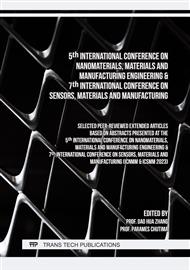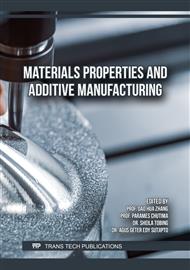[1]
Wong, K. V., & Hernandez, A. (2012). A review of Additive Manufacturing. ISRN Mechanical Engineering, 2012, 1–10.
DOI: 10.5402/2012/208760
Google Scholar
[2]
Song, R., & Telenko, C. (2017). Material and energy loss due to human and machine error in commercial FDM printers. Journal of Cleaner Production, 148, 895–904.
DOI: 10.1016/j.jclepro.2017.01.171
Google Scholar
[3]
3D printer support material: Which one to use for my project? All3DP. (2019, July 29). Retrieved July21,2022,https://all3dp.com/2/3d-printer-support-material-which-one-to-use-for-my-projectfig
Google Scholar
[4]
Dwamena, M. (2021, January 15). Does 3D printer Filament Go Bad/expire? how to tell. 3D Printerly. 7/27/23 https://3dprinterly.com/does-3d-printer-filament-go-bad-expire-how-to-tell/.
Google Scholar
[5]
Anderson, I. (2017). Mechanical properties of specimens' 3D printed with virgin and recycled polylactic acid. 3D Printing and Additive Manufacturing, 4(2), 110–115. https://doi.org/.
DOI: 10.1089/3dp.2016.0054
Google Scholar
[6]
Yuniarto, K., Purwanto, Y. A., Purwanto, S., Welt, B. A., Purwadaria, H. K., & Sunarti, T. C. (2016). Infrared and Raman Studies on polylactide acid and polyethylene glycol-400 blend. AIP Conference Proceedings.
DOI: 10.1063/1.4945555
Google Scholar
[7]
Grigora, M.-E., Terzopoulou, Z., Tsongas, K., Bikiaris, D. N., & Tzetzis, D. (2022). Physicochemical characterization and finite element analysis-assisted mechanical behavior of polylactic acid-montmorillonite 3D printed nanocomposites. Nanomaterials, 12(15), 2641.
DOI: 10.3390/nano12152641
Google Scholar
[8]
Jubinville, D., Tzoganakis, C., & Mekonnen, T. H. (2022). Recycled pla – wood flour based biocomposites: Effect of wood flour surface modification, pla recycling, and Maleation. Construction and Building Materials, 352, 129026. https://doi.org/10.1016/ j.conbuildmat.2022.129026.
DOI: 10.1016/j.conbuildmat.2022.129026
Google Scholar
[9]
Umamaheswara Rao, R., Venkatanarayana, B., & Suman, K. N. S. (2019). Enhancement of mechanical properties of PLA/PCL (80/20) blend by reinforcing with MMT nanoclay. Materials Today: Proceedings, 18, 85–97.
DOI: 10.1016/j.matpr.2019.06.280
Google Scholar
[10]
Salah, L. S., Ouslimani, N., Danlée, Y., Beltrán, F. R., Huynen, I., & Ulagares de la Orden, M. (2023). Investigation of mechanical recycling effect on electromagnetic properties of polylactic acid (PLA) – nanoclay nanocomposites: Towards a valorization of recycled PLA nanocomposites. Composites Part C: Open Access, 10, 100339.
DOI: 10.1016/j.jcomc.2022.100339
Google Scholar
[11]
Othman, S. H., Ling, H. N., Talib, R. A., Naim, M. N., Risyon, N. P., & Saifullah, M. (2019). PLA/MMT and PLA/Halloysite Bio-Nanocomposite films: Mechanical, Barrier, and transparency. Journal of Nano Research, 59, 77–93. https://doi.org/10.4028/ www.scientific.net/jnanor.59.77.
DOI: 10.4028/www.scientific.net/jnanor.59.77
Google Scholar
[12]
Correia, C., Gomes, T. E., Gonçalves, I., & Neto, V. (2022). Reprocessability of PLA through chain extension for fused filament fabrication. Journal of Manufacturing and Materials Processing, 6(1), 26.
DOI: 10.3390/jmmp6010026
Google Scholar



